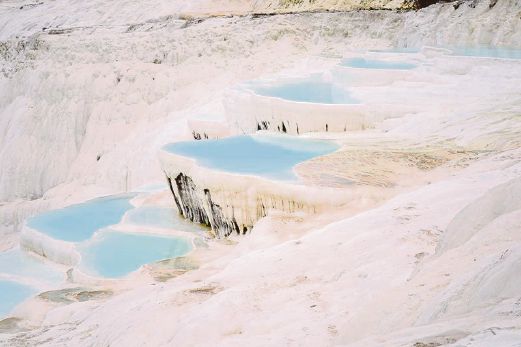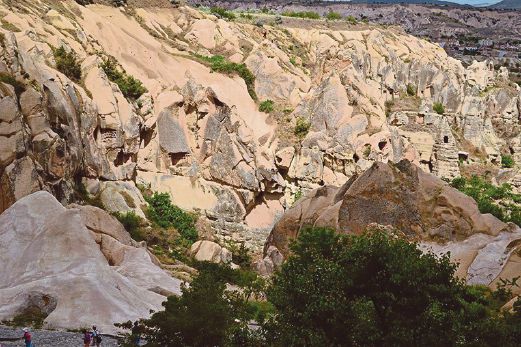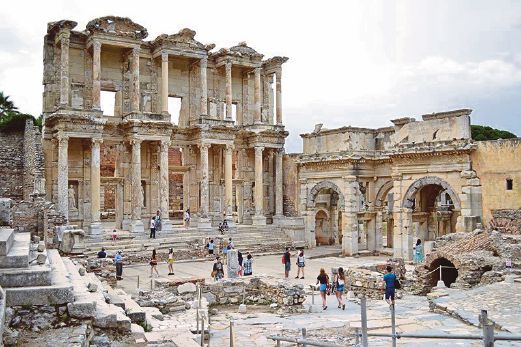NOT long ago, a jogging pal told me rather emphatically: “You must visit Turkey, a country with unique landscape, rich in history, yet so modern and liberal in outlook!”
So, with my imagination fired up and my wife in tow, I join a nine-day tour to Turkey.
It is late spring and the weather is perfect. The daytime temperature is about 23ºC, with clear blue skies and the occasional fine drizzle.
As soon as we arrive in Ankara, the capital of Turkey, we head straight for Anitkabir, a monumental tomb where the mausoleum of Mustafa Kemal Ataturk, the founder and first president of the Turkish Republic, is sited.
The Anitkabir itself is simple and timeless in style, yet grand and imposing, with guards parading in front of it. The museum showcases how the Republic Of Turkey came into being and why it is today modern and liberal.
Then we go to Cappadocia, best known for its fairytale landscape of unusual formations resembling chimneys, cones, mushrooms and pinnacles.
Inside the soft volcanic rock formations are underground cities (the biggest being Kaymakil) carved out over the centuries by early Christians, trying to escape from persecution. But since these underground cities are not for the tall (and I am tall) and those with claustrophobia, our guide advises us to go to the open air museum in Goreme Valley instead, which has hundreds of chapels carved into the hillsides. In one of them, the Dark Church, some mosaic paintings of religious icons can still be seen, though they have faded over time.
Hot air balloon rides at sunrise are a popular way to enjoy a panoramic view of the spectacular landscape. But due to a fear of heights, we give it a miss. The camera buffs in our group have a field day clicking away at the picturesque and breath-taking landscape.
Then we move south west to a mesmerising world heritage site, Pamukkale (“cotton castle” in Turkish), famous for its spectacular white terraces. Our guide explains that these unique geological features, made of travertine, were formed by channelling hot spring water containing calcium carbonate onto terraces.
Next we journey west to Selcuk to visit the ruins of Ephesus, one of the best preserved ancient cities in the world. Ephesus was one of the largest cities in the Roman Empire, boasting one of the seven wonders of the ancient world: The Temple Of Artemis.
The ruins we see include the massive amphitheatre, the impressive Temple Of Hadrian and the magnificent Celsus Library, a two-storey structure which holds 12,000 scrolls of manuscripts. I am so tempted to jog to the top of the amphitheatre to test my stamina but one murderous glare from the wife kills that idea immediately!
For Catholics, the highlight in Ephesus must surely be the visit to the House Of The Virgin Mary on Mount Bulbul. The small stone cottage was where the Virgin Mary was said to have spent her remaining years after the death and resurrection of Jesus Christ.
Pilgrims are allowed to pray before an altar inside the cottage while on the outside they can tie their prayers, written on strips of paper, to a special wall. My wife promptly writes a prayer on a facial tissue and sticks it amongst the thousands of prayer strips on the wall, confident that the Virgin Mary will intercede on her behalf!
Then we are off to Canakkale to visit the ruins of Troy. I am very excited about seeing Troy because of the legend of Helen of Troy. When Paris, a prince of Troy, abducted the most beautiful woman on earth, Helen, queen of Sparta, it sparked a 10-year war between Greece and Troy. The legend ends with how the Greeks used a humongous wooden horse to gain entry into a heavily fortified Troy to rescue their queen. I learn that Troy is an archaeological site on the world heritage list but I am rather disappointed at the ruins uncovered to date. Other than a replica of the wooden horse, there is little to see.
There are more ruins in store at the next stop, Pergamon. A remark from an elderly tour member, “What? See another mound of stones again!”, brings a chuckle to many. For me viewing ruins need a lot of imagination and background reading.
At Pergamon, we visit the impressive ruins of Asklepeion, a famed ancient medical centre built in honour of Asklepios, the God of Healing. The hospital built during Roman times was devoted to psychological disorders and adopted a holistic approach in the belief that the people’s souls needed to be mended as well as their bodies. This explains why a theatre was also part of the complex.
Finally we cross the Dardanelles (a narrow straits connecting the Aegean Sea to the Sea Of Marmara) as we make our way to Istanbul. Enroute we see swaths and swaths of farmland and orchards that produce crops and fruit for Turkey and much of Europe.
Do you know that Istanbul, formerly known as Constantinople, is the only city in the world where you can have breakfast in Europe and lunch in Asia? This is because Turkey straddles two continents which are separated by the Bosphorus Straits but are connected by several bridges, the most famous being the Bosphorus Bridge.
We are told that in 2013, Tiger Woods hit a ball from Europe to Asia across the Bosphorus Bridge as part of a publicity stunt!
One place tourists shouldn’t miss is the majestic Sultan Ahmet Mosque, at one time the supreme imperial mosque of the Ottoman Empire. Also known as the Blue Mosque, the interior upper levels and piers are exquisitely lined by turquoise tznik-style ceramic tiles. Dimly-lit chandeliers give the interior an aura of serenity despite the intense tourist crowds. The grey exterior, with its six minarets and many domes, give it a commanding presence.
Another top attraction near the Blue mosque, is the Hagia Sophia Museum. This was originally a church boasting the largest cathedral for almost 1,000 years. In 1453 it was converted to a mosque by the Ottoman Sultan Mehmet II but President Ataturk turned it into a museum in 1935.
Next we head for Topkapi Palace Museum to get a glimpse of the opulent lifestyle of the Ottoman sultans, their wives, children and concubines. The site is huge, with four main courtyards, the harem, historic buildings and pavilions encircled by sprawling gardens.
Everything there is opulent. Among the displays are a gold cradle, a dagger with a hilt of emeralds and a sheath of gold and diamonds, and the so-called Spoonmaker’s Diamond, a 86-carat pear shaped jewel in a setting of 49 smaller diamonds.
Though shopping is not on our agenda, we still stop at the Grand Bazaar, one of the oldest and largest covered markets in the world with over 4,000 shops in 61 streets. This colourful and chaotic market is so massive that one can easily get lost in the maze.
A wide range of merchandise is sold, from rugs and handmade carpets, jewellery, antique, leather products, ceramic wares to souvenirs. But our guide warns us not to do any “serious shopping” here at the risk of being fleeced.
Yes, fascinating Turkey has lived up to my expectations.
Write in
If you enjoy sharing your travel stories gratis, then this column is for you. Email your stories (not more than 800 words with at least four pictures and captions) to [email protected].




